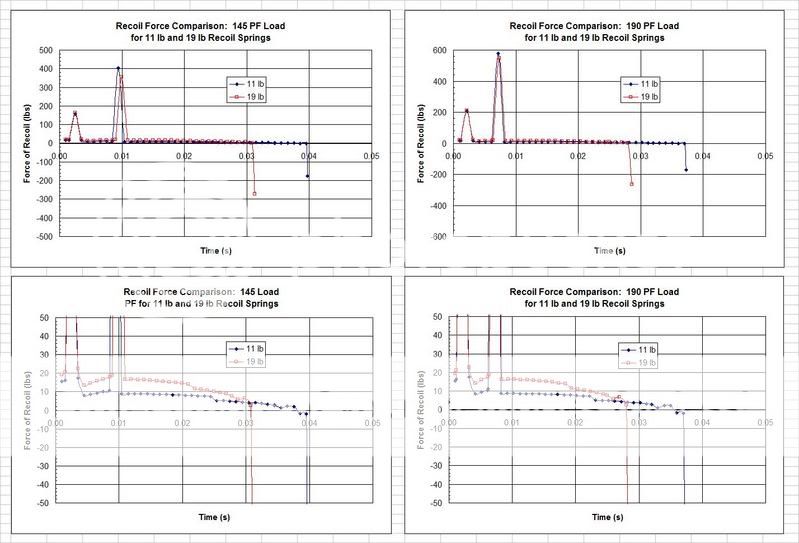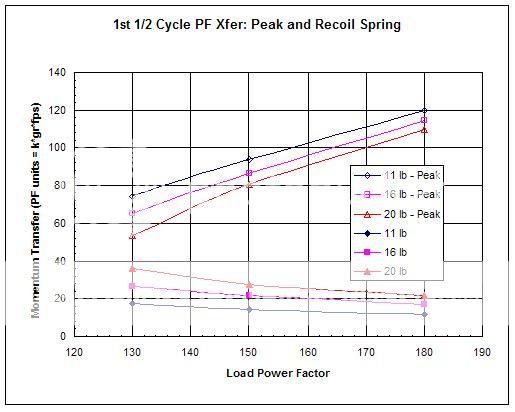Posted by double_pedro on SigForum. I have not grokked the whole thing yet. I am at work. Thought some might find it interesting.
http://sigforum.com/eve/forums/a/tpc/f/150601935/m/474102588
http://sigforum.com/eve/forums/a/tpc/f/150601935/m/474102588
Discussion
Some interesting points may be noted from the results presented above. To explore these, I have posed specific questions and tried to answer them in the context of the calculation.
Does a light recoil spring “shoot flatter”?
First, the momentum transferred in the 1st ½ cycle is very nearly equal to the momentum of the load (Load PF). This is because for this example the minimum value for the inelasticity parameter was used in the calculation (to characterize the collision between the slide and frame). Note that the relative slide speed after the collision is very close to zero (see graph above). I believe this is fairly representative of the actual collision process (i.e. very inelastic) and it also happens to minimize the momentum (recoil) imparted to the frame/shooter.
An important ramification is that the second half of the recoil cycle transfers very little net momentum to the frame/shooter (only 1 PF out of 145). However, the frame/shooter does experience additional “push” backwards from recoil during most of the 2nd half of the recoil cycle, followed by a jerk forward as the slide slams into battery. The momentum transfers from each of these are nearly equal and oppositely directed. Further, the size of each of these momentum transfers (and the slide speed during the 2nd ½ cycle) depends strongly on the recoil spring since it is the recoil spring that is accelerating the slide from (near) rest into battery. I believe this is the reason that many shooters feel that lighter recoil springs “shoot flatter” than heavier springs. The net sight return may not be all that different, but I believe the sights move up and down more if a heavier recoil spring is used (e.g. 11 lb vs. 19 lb).
The following graphs compare the force of recoil transferred to the frame/shooter for two different loads (145 PF and 190PF) and two different recoil springs (11 lb and 19 lb). The upper and lower graphs differ only in scale. As mentioned earlier, the magnitude of the “sudden” force when the slide hits the frame and returns to battery assume that these collision occur over one time step (0.001s) used in the calculation. If the actual collisions occur over a longer (shorter) time, the momentum transfers in these collisions will be unaffected but the actual force will be proportionately less (greater) than that shown.

How much does the recoil spring reduce slide-frame “pounding”?
Recoil springs with ratings that are typically found in use (10 – 20 lbs) do relatively little to "protect" the gun from slide-frame pounding. Looking at the table above for the current example of an 11 lb recoil spring, during the 1st ½ cycle, the amount of momentum transferred to the frame/shooter by the recoil spring is only about 15 PF or 10% of the PF of the load. This is the amount of “protection” that the recoil spring provides. Furthermore, as the PF of the load increases, the amount transferred by the recoil spring drops since the increased slide speed reduces the time it takes to complete the 1st ½ cycle. As a result, the recoil spring doesn’t have as long to act before the slide hits the frame. The same holds for the force to cock the hammer and extract the empty case. The barrel unlocking from the slide and hitting the frame transfers nearly a fixed percentage of the load PF (the ratio of the barrel mass to the slide + barrel mass) and the rest (which is still a good percentage of the load PF) the gets transferred suddenly when the slide hits the frame at maximum recoil travel.
The following graph shows a comparison of the peak PF transferred and that transferred by the recoil spring during the 1st ½ cycle for different loads.

As can be seen, as the PF of the load increases, the (small) momentum transfer by the recoil spring becomes even smaller and the peak transfer increases. As a result, even with a heavy recoil spring (e.g. 20 lbs), the slide and frame still take a beating - so much so that it is hard to imagine that recoil springs with ratings that are typically in use play much of a significant role in “protecting” or extending the service life of a pistol.
Another way to approach this is that for the 145 PF load example under consideration, 89 PF of momentum are suddenly transferred to the frame/shooter when the slide hits the frame at maximum recoil travel. If the load is increased to 180 PF, the recoil spring would have to be increased to 36 lb in order to keep the momentum transfer the same (89 PF) when the slide hits the frame.
If it doesn’t protect the slide, what does the recoil spring actually do?
The primary purpose of the recoil spring is to ensure that the slide returns to battery and does so in controlled fashion for reliable feeding. Assuming an inelastic slide-frame collision process, the recoil spring affects the slide speed into battery more than anything else. A heavier spring means faster return to battery, and vice verse. It is this aspect that may (adversely) affect reliability. Obviously, the recoil spring must be heavy enough to overcome the drag forces associated with feeding. In addition, if the recoil spring is too heavy, the slide may return to battery too quickly and cause feeding problems if the rounds in the magazine have not sufficiently settled from the recoil of the 1st half cycle. If the slide-frame collision process is more elastic, then the influence of the recoil spring becomes less, since more of the slide’s energy will be retained in the collision process. As a result, the slide speed in the 2nd half cycle will end up being less dependent on the recoil spring weight.
In short, if the slide frame collision process was sufficiently elastic, there would be little need for a recoil spring at all since it plays a relatively minor role in recoil transfer during the 1st ½ cycle (as noted above) and would not be necessary to return the slide to battery in the 2nd ½ cycle. In reality, I believe the slide-frame collision is very inelastic so there is a need for a recoil spring to ensure that the slide returns to battery (even for a totally inelastic slide-frame collision).
How does “limp wristing” lead to feed malfunctions? Is it related to slide speed?
"Limp Wristing" is not a (slow) slide speed problem. Limp wristing removes the shooter from the effective mass against which the slide recoils. Without the shooter’s mass in the recoil, the frame is subject to much larger acceleration and this leads to a problem in which the rounds in the magazine are (relatively speaking) pushed down in the magazine during under-controlled recoil. The rounds are unable to recover in time before the slide gets to the feeding portion of the recoil cycle. In support of this description, if one reduces the effective frame/shooter mass in the calculation, the recoil process yields significantly more frame movement (up to 4 cm = 10x more) during recoil. As noted above, the momentum (and therefore speed) with which the slide closes is primarily determined by the recoil spring. Using a lighter recoil spring results in a slower slide speed during the feeding portion of the cycle, and therefore may result in more reliable operation when limp wristing may be an issue.
Do I need to increase the recoil spring weight if I install a lighter main spring?
No. As can be seen in the output table, the effect of cocking the hammer on the recoiling slide (listed under “Oth Sumd PF Xfer”) is even less than the recoil spring. The effect of a change in the main spring weight will be very small and even then primarily affect the 1st half cycle. Slide speed during this half cycle is not very sensitive to the recoil or main spring weight, nor is the momentum transferred to the frame when hit by the slide at maximum recoil travel.
Is there an “optimal” recoil spring weight?
This depends on how one defines “optimal”. For most applications, this would be a balance of reliability and the most controllable recoil. As discussed above, reliability relies on the slide to return to battery (every time) but not so quickly that the rounds in the magazine have not had a chance to settle from the recoil of the 1st ½ of the cycle.
This raises the issue of “controllable recoil”. The most critical aspect of this is to ensure that the slide-frame collision is totally inelastic and that the recoil spring is as small as it needs to be in order to ensure the slide returns to battery every time (under operational conditions with appropriate safety margins). As mentioned earlier, a totally inelastic slide-frame collision minimizes the momentum transferred to the frame/shooter in the 1st ½ cycle. It also minimizes the forward jerk that occurs as the slide slams into battery. I believe the slide-frame collision is very inelastic to begin with, so relatively little needs to be done in this regard. However, one could consider adding a soft “shock buffer” between the slide and frame to extend the slide-frame collision over a longer time (as well as the overall cycle time). The net momentum transfer would be the same, however, the “feel” may be different (perhaps more appealing) to a particular shooter or application. The important point here is that the buffer needs to be soft (inelastic) so it acts like a cushion rather than a spring or bumper.
Last edited:
